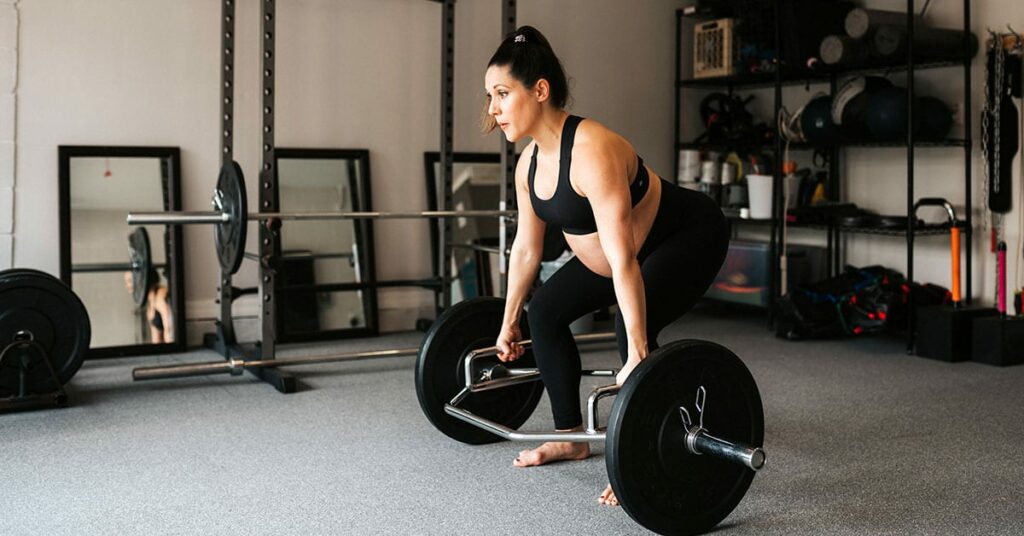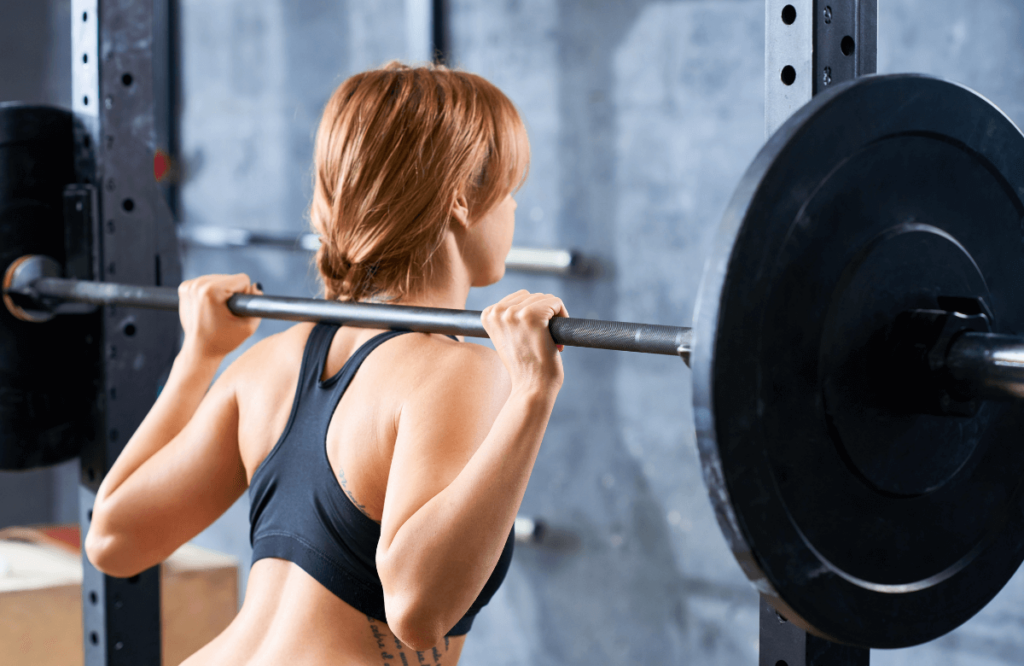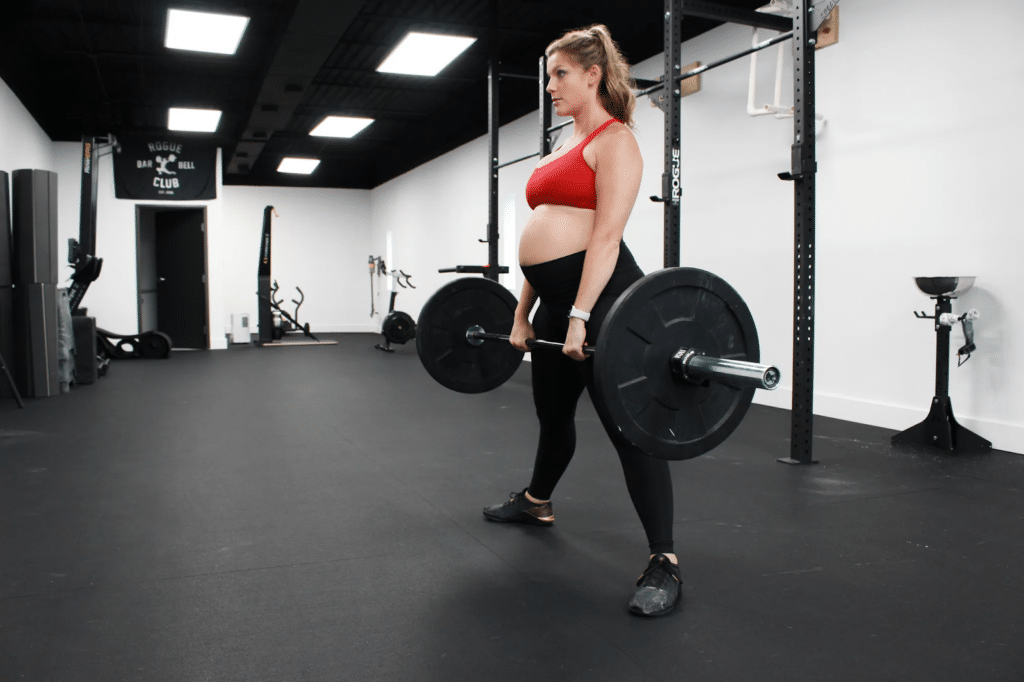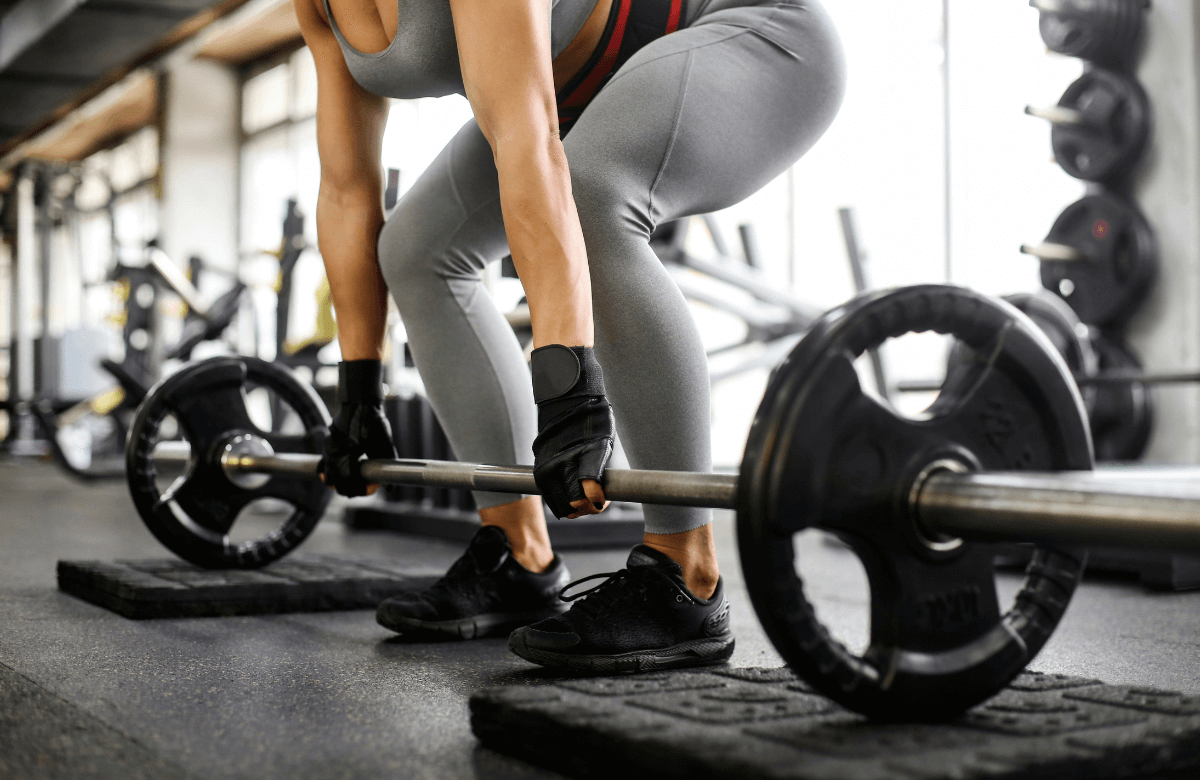An active pregnancy is one of the healthiest and safest decisions a woman can make for herself and the baby. There is a ton of misinformation surrounding whether women should do deadlifts while pregnant.
Fortunately, consistent evidence shows the benefits of strength training and the positive impact on the baby’s and the mother’s health. In this article, I’ll cover how to deadlift safely during pregnancy, so you can keep your body active even with lighter weights.
Jump to:
Benefits Of Lifting Weights While Pregnant
Strength training exercises have little to no downsides when it comes to pregnancy, especially if you were doing any physical activity before pregnancy. That will make muscle memory an ally. Proper breathing techniques and simple movement patterns such as body weight squats, chest presses, deadlifts, and hip extensions can benefit you and your baby.
1. Strengthen Your Core And Pelvic Floor
A solid core is one of the foundations of successful training programs. Most of the body’s power comes from the core. Abdominal muscles are not only responsible for stabilizing movements but also for energy transfer.
The stronger your core, the more efficient you become at doing lower and upper body movements. Plus, your spine remains healthy for longer, which is crucial for a healthy pregnancy.
The pelvic floor muscles‘ primary function is stabilizing the core and pelvis to help you control the spine more efficiently. These muscles are also in charge of handling your bladder, uterus, and bowel. The deadlift is crucial for these body sections since it works the hip and gluteal musculature, both essential for preserving core and pelvic floor function.
2. Keeps Your Body Active
Pregnancy is a delicate and vulnerable state for women, but it doesn’t mean you shouldn’t exercise. The more your body moves, the more it wants to move. The opposite is also true. It’s more beneficial to exercise during pregnancy than to stay passive throughout the process. This, of course, varies individually. But, for the majority of women, the pros outweigh the cons.
Pregnant women should be encouraged to lift weights and move safely and efficiently during this stage in order to preserve and build muscle mass.

- May Accelerate The Recovery Process
Lifting weights is the best way to keep your muscles strong and healthy, increasing your body’s ability to recover from stress. The stronger your muscles are, the faster you can bounce back from any injury, or, in this case, pregnancy.
- Improves Your Mood
One of the main benefits of exercising is the release of serotonin from your brain. Serotonin is the neurotransmitter responsible for improving your mood and keeping you in a healthy state of mind. In other words, it helps you stay optimistic, which is fundamental when going through such a challenging state as pregnancy.
How To Modify Your Deadlifts While Pregnant
Years ago, lifting weights was prohibited by some physicians because they thought it was dangerous. Sadly, most carry the same thinking even today. However, you can modify your deadlift in many ways to keep you training during pregnancy. Here are a few tips!
1. Lower The Weight
The current consensus is in favor of lifting weights during pregnancy as long as certain modifications are made to adjust to the natural progression of the baby getting bigger. One of those modifications includes lowering the weight for the deadlift. I’d recommend keeping the weight below 70% of your 1RM (click here to calculate it).
By doing this, your body can still enjoy the benefits of working out, but with less strain. It’s important to remember that your range of motion will be compromised, which may affect your ability to lift the weight with the same ease as before.
Safety first! Although we recommend a top weight of 70% of your 1RM, reconsider this daily. Some days you may feel more pain than others, and the weight has to decrease even more.
2. Limit The Range Of Motion
As the pregnancy evolves, your baby will get bigger, limiting the range of motion for most exercises, including the conventional deadlift (especially after the second trimester.). I’d recommend decreasing the bar path by putting the weights on top of disc plates or blocks in those scenarios. Or you can try a different deadlift variation, such as the sumo deadlift.
The sumo deadlift has a wider stance than the conventional style, which creates more space for your baby in the bottom position. This way, you can keep the intensity up while caring for your pregnancy.

3. Manage The Volume And Intensity
The training volume refers to the total weight, sets, and reps you accumulate during a lifting session. The higher the volume, the more stress you put into your body, which is already under enough strain from the pregnancy.
The intensity in training means how hard and faster you train, including recovery. The less you rest, the more the workout intensity increases, and vice versa. Although this is what you’d want under other circumstances, it could compromise your pregnancy’s safety. Here are some general tips:
– Keep the weight below 70% of your 1RM.
– 2-3 sets for each movement.
– Don’t go to muscle failure.
– Rest 24-48 hr between lifting sessions.
4. Don’t Deadlift Every Day
Deadlifting every day could increase the stress on joints such as the hip and lower back. During pregnancy, these joints are already under stress due to the natural anatomical adjustments the body makes to create more space for the baby.
Adding more tension with daily deadlifts could worsen this symptom and increase the delivery risk. On top of that, it’ll also limit your body’s ability to recover correctly from one session to another. As a sweet spot, aim to deadlift 1-2 times per week and prioritize rest and recovery.
Mistakes To Avoid
There are some mistakes that you should avoid to maximize the benefits of deadlifts while you’re pregnant. Having a fitness trainer can also help you keep injuries at a minimum. However, if you’re on your own, here are some that you should consider.
1. Going Too Heavy
Too heavy on the deadlifts could hurt your proper form and expose you to a more significant injury risk. I wouldn’t recommend lifting more than 70% of your 1RM, independent of how many months pregnant you have.
Your approach to weightlifting should be challenging yet conservative. It’s also worth mentioning that exercise doesn’t need to be heavy to be effective. You can implement resistance bands, tempo, and variations of the same movement.

2. Poor Technique
Mastering your lifting technique should be a priority even before pregnancy. A bad form on the deadlift could jeopardize your spine’s health (who’s already under enough strain) and increase your risk of injury. Make the necessary adjustments to keep your technique clean, such as lowering the weight, decreasing your range of motion, or trying different deadlift styles.
As a reminder, keep in mind the following tips for a better and healthier technique:
– Keep your chest upright.
– Maintain a neutral spine and neck.
– Brace your core before lifting the bar.
– Lock out your hips and knees at the top.
– Keep the bar close to you.
If your form needs to improve, try lowering the weight or limiting the range of motion.
3. Deadlifting Every Day
Although weight training is beneficial, deadlifting daily can harm your spine health and pelvic floor. During the late stages of pregnancy, your pelvis is set anteriorly, which hyperextends your spine, increasing the tension.
Adding the extra stress from the deadlifts could increase the risk of spine injury. Instead of doing it daily, aim to deadlift twice weekly with a manageable weight and clean technique.

When Should You Consider Stop Lifting
The benefits of strength training are many. However, there are some scenarios where the risk is not worth it.
Pain
During a normal pregnancy, experiencing some pain it’s expected. But, when it comes to deadlifting pain, measures must be taken. No exercise should be painful when two lives are at risk (mother and baby.) Although the deadlift has multiple benefits during pregnancy, it can also cause pain if variables such as technique, volume, and intensity are not honored.
If you’re experiencing pain during this exercise, I suggest you stop doing it and ask your Doctor and personal trainer about possible solutions and alternatives.
Diastasis Recti
Diastasis recti, also known as “diastasis recti abdominis” (DRA), is a condition by which the rectus abdominus muscles are separated from each other in the linea alba (abdominal wall midline)
This condition usually occurs under high and often chronic episodes of increased intra-abdominal pressure (IAP), such as pregnancy, and exercises such as deadlifts and squats. Although this happens more often during postpartum, it’s not uncommon to see it throughout different stages of pregnancy. If you’re experiencing DRA, I’d advise you to stop lifting until the leading cause has been addressed.
In the mid-time, you can focus on other movements that don’t increase the IAP as much.
Abnormal Pregnancy (high-risk pregnancy)
An abnormal pregnancy can be anything that threatens the natural evolution of the pregnancy. If your head doctor is suspecting any condition in particular, you should consider stopping deadlifts and focusing on lighter exercises until you have a precise diagnosis and treatment plan. Although deadlifts could be beneficial depending on the abnormality, it’s better to bias safety and wait until having a clearer picture.

FAQ
How Much Can I Deadlift While Pregnant?
Generally, I recommend keeping your deadlift below 70% of your 1RM (click here to calculate it). Although you could go heavier, it’s not worth the risk. Your spine and hips are already under enough stress, which could increase the risk of injury if you decide to go extra heavy.
Is It OK To Lift Weights While Pregnant?
Yes, it’s ok to lift weights while pregnant. It is recommended you do so. Exercising will keep your mind and body in the right tune to endure the physical and mental strain of going through a pregnancy. Your muscles will preserve strength, and your mood will be steady.
Are Romanian Deadlifts Safe During Pregnancy?
Romanian deadlifts are safe during the first trimester of your pregnancy. From then on, your baby will grow and limit your range of motion, hindering your body’s ability to flex the hips and take advantage of the Romanian variation. After the second trimester, we recommend reducing the range of motion, so you can still enjoy the benefits of the movement.














